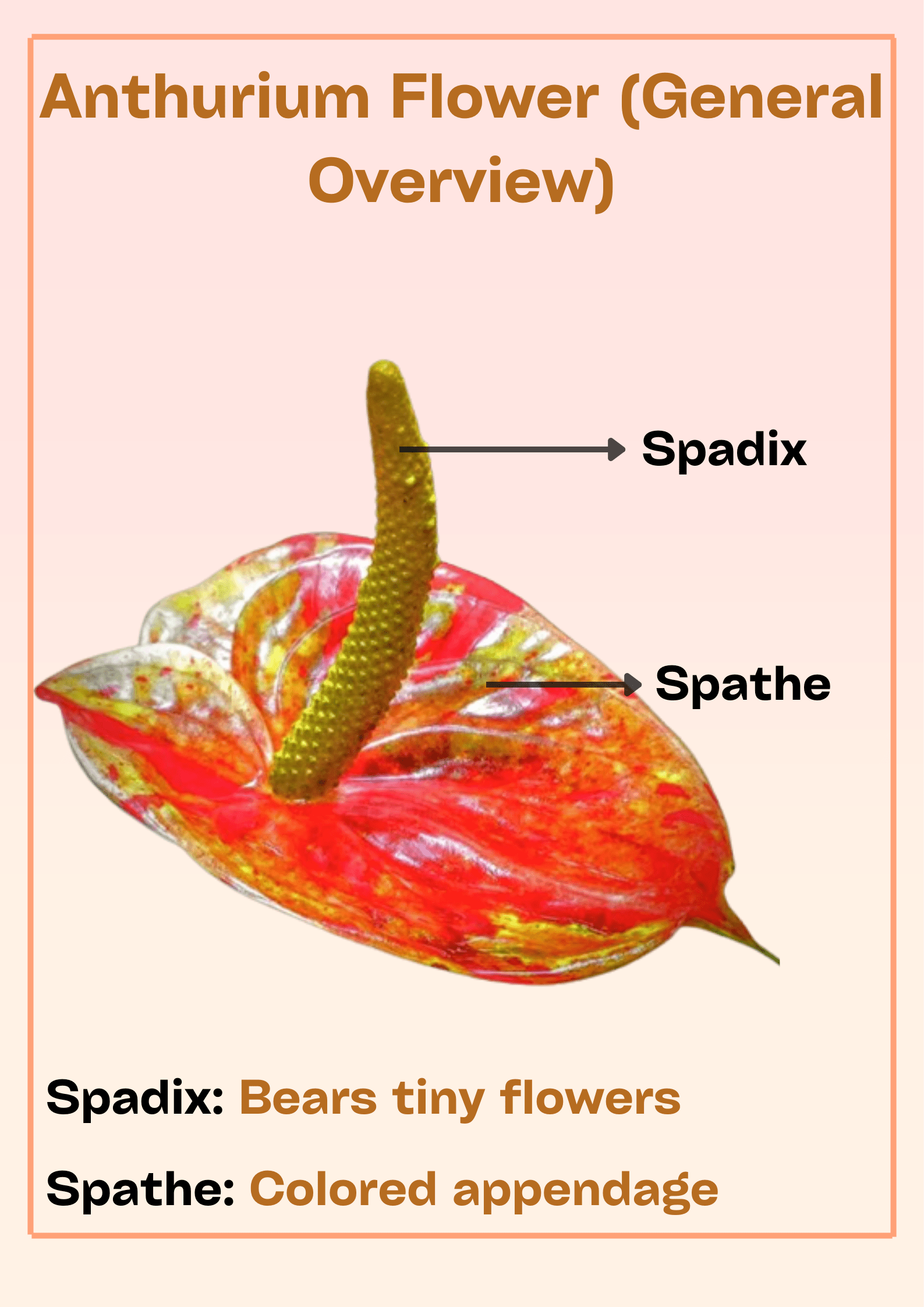Anthurium flowers are famed for their style, elegance, and rarity in design. With their unique flowers and several varieties to pick from, Anthuriums are among the most desired houseplants.
In fact, the compliments described above for the Anthurium flowers are meager to end this debate on a convincing note. So, let’s learn better about the flowers of Anthurium.
Table of Contents Show
What do Anthurium Flowers Look Like?
At a glance, it seems like the spathe encases the spadix, just like a garland on someone’s neck!
The flower consists of a wide, glossy or ruffled, variously-shaped, colorful, and leafy “spathe,” representing the decorative part of the flower. A slender “spadix” surfaces proximally from the spathe.
Want to know more about the Anthurium flowers? Check this table below!
| Attributes | Characteristics |
|---|---|
| Common Name | Flamingo flower, Flamingo lily, Painted tongue, Painter's palette, Hawaiian heart, Tail flower, Laceleaf, etc. |
| Scientific Name | Anthurium species |
| Spathe | Size: Ranging from 7-9 centimeters Shape: Tulip, Heart, Spoon, Ribbon, or Cup-shaped Color: Pink, Purple, Red, Green, Cream, Brown, White, or Mixed Feature: Deeply veined |
| Spadix | Size: Ranging from 8-15 centimeters Shape: Cylindrical, Elongated, Finger-shaped, Curved, or Straight Color: Green, Yellow, Orange, White, Cream, Dark Red, Red, or Mixed Feature: Small bumps which are its bisexual flowers (both male and female parts present) |
| Flowering Season | Spring, Summer, Fall, and Winter, with blooms lasting for 2-3 months |
| Pollination | Type: Cross-pollination Season: Spring, Summer, Fall, and Winter (every 2-3 months) Vectors: Flies, Butterflies, Bees, and Weevils |
| Fruiting Season | Spring, Summer, Fall, and Winter Matures 5-8 months following pollination |
| Uses and Symbolism | Uses: Cut flowers, decorations, funeral bouquets, etc. Symbolism: Served as hospitality gifts |
| Special Features | Spadices of some species heats in winter Colorful spathe helps to attract the pollinators Plant parts along with flowers carry toxic traits |
What are Anthurium Flower Stages?
The sexual or flowering stages include; unfurling of the spathe, development of spadix, male and female anthesis, pollen formation, pollination, and fruit formation.
Spathe opens year-round, exposing the erect and fleshy spadix that bears numerous florets (small flowers).
The spadix is like a stand to hold tiny bisexual flowers. So, each bump or dot you see is a developing flower.
Each flower has male (anther) and female (stigma) parts.

Florets develop in a bottom-up manner, and the female’s stigma becomes sticky with the exudate to receive the pollens from males.
The stigma becomes receptive every day for up to 2 weeks. Meanwhile, the anther keeps bearing dusty white pollens.
Various insects, which are attracted by the sweet or unpleasant aroma, pollinate the flowers.
After pollination, the florets turn brown. Within 5-8 months, round fruits replace the dead florets.
Fruits or berries are of various colors unique to each species and nurse about one to three seeds.
Collect the seeds by squeezing the berries with your fingers, scraping the pulp, and placing them on a paper towel to dry.
If your Anthurium loses flower, look for reasons and fixes.
How to Make Anthurium Flower?
Bereft of any condition may hamper the vegetative growth and the flowering cycle of Anthuriums.
So, you need to mimic a tropical environment for them to incite flowers.
- Place your Anthurium in a spot receiving dappling sunlight.
- Use a well-draining and moisture-retentive peat or pine bark-based potting soil with a pH between 5 and 6.
- Sustain the daytime temperature around 25-32°C and overnight temperature around 21-23°C.
- Anthurium flowers get a glossy and healthy finish if the indoor humidity levels are maintained at 50-70%.
- Water every 2-3 days with distilled or rainwater in summer and cut watering in winter.
- Consider repotting every 2-3 years when the plant becomes root-bound or roots protrude from the drainage holes.
- Fertilize your Anthuriums weekly with a high-phosphorous-based liquid fertilizer diluted up to 10-20% strength.
- You can prune or remove the dead or diseased parts in spring to ensure the flower is healthy.
- Deter pest or disease incidence by casting them off with water or scrubbing the leaves and stems with neem oil once a month.
- Relocate the diseased plant away from other healthy plants to stop the extent of diseases.
If your baby Anthuriums are ready to transplant, assign them the task during spring and summer.
Anthurium Flower Meaning & Symbolisms
The typical meaning of Anthurium flowers is hospitality. For example, presenting someone with Anthurium flowers means your gesture of friendliness.
Additionally, flowers are also used in funeral bouquets or arrangements due to their unique designs and meanings.
1. Anthurium Flower Color
Flowers of Anthurium Varieties are symbolically astounding because the spathe’s color carries a special meaning.
Pink Anthurium flowers represent femininity and birthhood, an ideal gift for soon-to-be mothers.

Similarly, the Red Anthuriums symbolize lust, passion, and love.
The gorgeous white spathe of some Anthurium flowers implies innocence and purity.
Likewise, Purple spathes of Anthuriums hint at decency and power.
2. Anthurium Flower in Feng Shui
In Feng Shui, Anthurium flowers are known to shower godsends.
Place a blooming Anthurium in the southwest area of your home to invite the Midas touch in amity and love, as the southwest area attributes love and friendship.
The flower also has a renowned meaning in the Chinese New Year.
People keep the flowers in their homes during the annual celebration of Chinese New Year to encourage good fortune for the upcoming year.
Wrapping Up…
Though Anthurium primarily boasts of wide-heart-shaped leaves, the flowers look elegant for home decor.
But the plant still is toxic, so enjoy the flowers in the pot when the plant starts blooming!
If your garden lacks flowering plants, try Begonia, Plumeria Rubra, Daffodil and Bird of Paradise.
